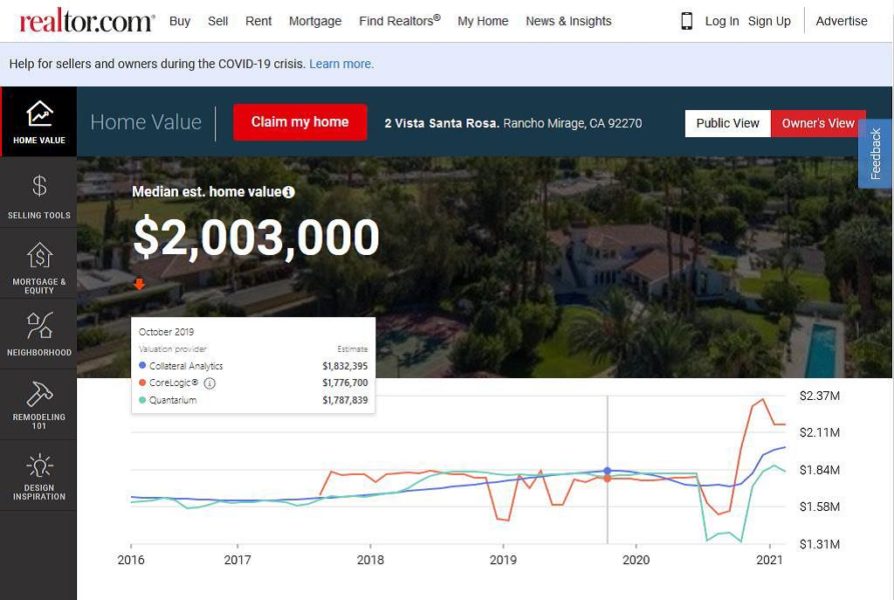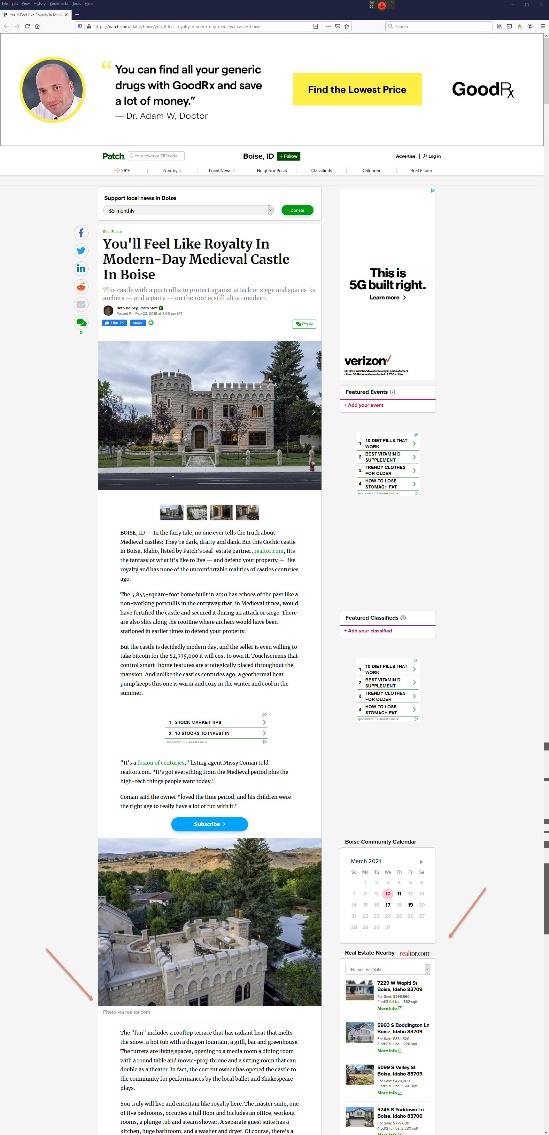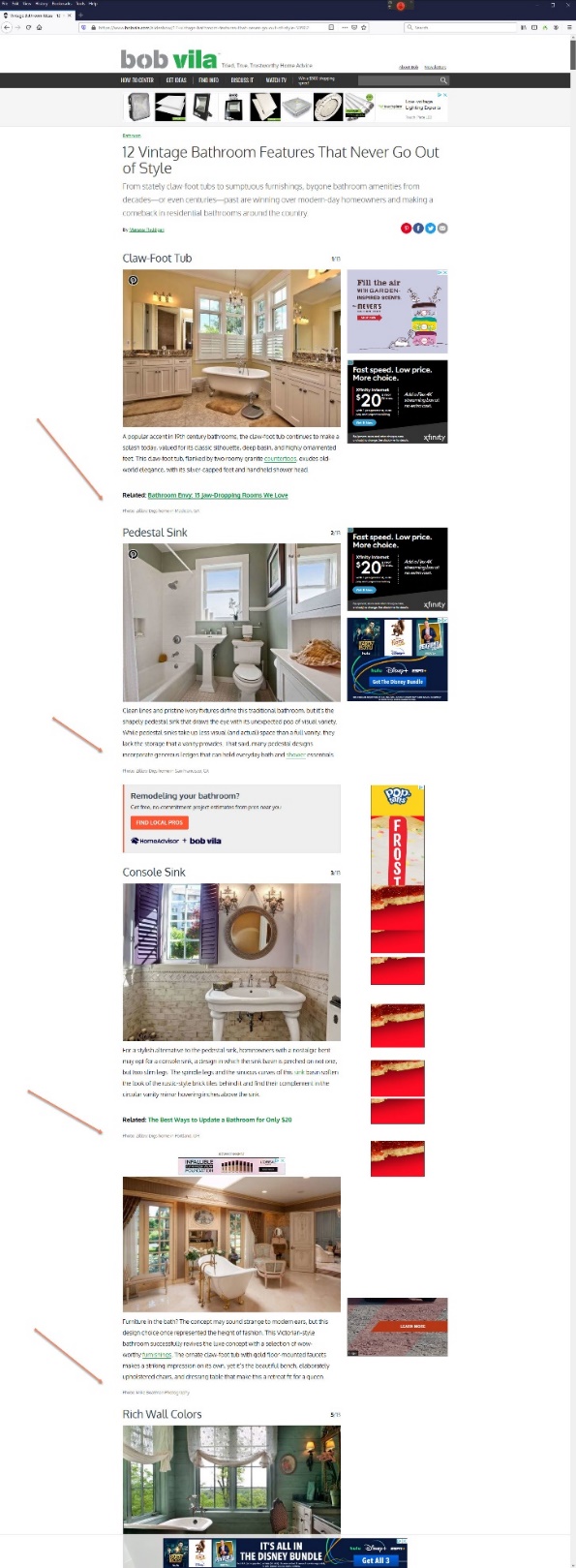Press release 2021:
QUESTION:
Is the real estate business sector violating federal law
and bullying another business sector?
ANSWER: Yes.
Real estate photographers are suffering financial loss because of unauthorized image use. If the offenders do not relent, the only recourse is through the legal system.
Two federal copyright litigations were recently filed:
- Michael Boatman vs Peoria Area Association of Realtors, (PAAR), civil action number 1:20-cv-01248-JES-JEH
- George Gutenberg vs Move, INC. {Realtor.com} case 2:21-cv-02382
There are numerous other photographers across the US poised to follow George Gutenberg’s example. The hope is for relief from unfair, possibly illegal business practices. From the interest shown in the real estate photography community, it is anticipated that substantially more photographers will be following with litigation. Because of the 3-month grace period afforded to copyright owners for registering imagery, their infringed images are eligible for statutory damages and attorney fees.
The crux of the issue is this (regardless of industry):
- The granting of copyright usages without the authority to do so is a copyright infringement. No individual or entity has the authority to grant usage rights to another entity unless they are the copyright owner or have been specifically granted that authority by the copyright owner.
- Any individual, business, corporation or association that uses the intellectual property of another person without the copyright owner’s authorization, especially if it is used for financial gain, has committed a copyright infringement.
The biggest copyright infringement abuse may be against real estate photography, depending on the number of rights-managed works. It might possibly surpass NAPSTER in scope of infringed works, given the sheer number of images produced (approximately half a million daily) then used by aggregators after the close of the listing agreement.
NAR statistics:
https://www.nar.realtor/research-and-statistics/quick-real-estate-statistics
“5.34 million Existing Homes were sold in 2019, according to data from the National Association of REALTORS®. 682,000 newly constructed homes were sold in 2019, according to the U.S. Census Bureau.”
This is a total of 6.022 million annual property sales. Using an estimate of 30 images per property, this represents approximately 180.6 million photos uploaded annually or 494,794 photos daily.
Currently, images being used outside of authorized usage by third parties are making millions of dollars at the expense of photographers, both inside and outside of the real estate industry. Photos from listings are showing up in the general advertising market being used as stock imagery without authorization.
Thus far, photographers who have tried to discuss the issue with MLS associations and/or aggregators have been shut down and in worst cases, made an example of. Some photographers who have pointed out copyright violations have been blacklisted by their MLS which has ended their real estate photography business.
Photographers regret that it has come to formal federal litigation. The consensus from most photographers is that their clients (real estate agents and/or brokers) are acting in good faith when they commission photos for the purpose of selling a listed property.
As pointed out by Boatman versus PAAR, the issue of unauthorized usage appears to originate at the MLS due to a penned agreement with Realtors Information Network (RIN agreement). The RIN agreement which originated in 1993 by NAR and is now the property of Move INC, {Realtor.com}.
Paragraph 4 of the RIN agreement states:
“During the terms of this agreement. Data provider hereby grants to RIN, its affiliates and authorized subcontractors a worldwide license to market, license, display, perform and promote the Licensed Data solely through the RPA. It is understood that all national account revenue derived from advertising through corporate national sponsorships whether the ads are displayed nationally or locally shall be RIN’s. …”
Per the RIN Agreement, “RPA” shall mean that site on the WWW located at http://www.realtor.com…”
It appears that this standardized agreement originating from NAR was a required document signed by most if not all MLS associations.
The Data Advocate/ RIN historical timeline: http://www.thedataadvocate.com/rin-timeline/
Additional information on the history of the RIN agreement: http://www.thedataadvocate.com/category/realtor-information-network-rin/
The standard and usual contract between photographers and the real estate agent and /or broker is for single use for the purpose of marketing to sell a specific property. Image usage rights are nontransferable to any third party. The photographer maintains ownership of all copyrights. Most real estate contracts terminate usage rights upon the sale or the close of the agents listing agreement. These terms have been acceptable to real estate agent and broker for years. Real estate agents have no interest in the photographs after the listing sells or if they lose the listing.
Even the NAR national rules state that you cannot force a copyright transfer of ownership. https://cdn.nar.realtor/sites/default/files/documents/2021_NAR_HMLP_210112.pdf
Section 15 page 32,
Participants cannot be required to transfer ownership rights (including intellectual property rights) in their listings or listing content to MLS to obtain or maintain participatory rights except that MLSs may require participants to grant the licenses necessary for storage, reproduction, compiling, and distribution of listings and listing information to the extent necessary to fulfill the defined purposes of MLS.
NAR ongoing education, “Copyright Best Practices” fully supports federal law as demonstrated in their YouTube video, Window to the Law: How to Avoid Copyright Infringement.
https://www.youtube.com/watch?v=6HQHsLpdBqo.
Unfortunately, even if an agent follows all the best practices outlined in the video, unless there is a copyright transfer of ownership to the MLS, the images are still going to be infringed. It is important to know that commercial photography is sold based on usage. Infringers are taking the equivalent of a buyout which is slightly less valuable than ownership, the highest value an image can have. It is not ethical to force photographers to transfer ownership for pennies which would undermine the entire pricing structure and business model of commercial photography.
This begs the question (and hopefully the Boatman vs PAAR litigation will answer): “Why does the MLS believe they can transfer usage rights and, in some cases, even sell usage rights without the authority of the copyright owner?”
Image value and aggregators:
While for the agent or broker the photos have no value after the sale of the listing or loss of the listing, this is not true for the aggregators, which George Gutenberg vs Move INC, will demonstrate.
The examples below of unauthorized usages are from multiple photographers.
Real dollars as reported in Inman for Realtor.com after the redesign of their website:
Realtor.com reports to Inman that a website re-design created a 14% increase, year-over-year.
“News Corp. subsidiary Move Inc.’s home search website is now faster, more visual, and more information-dense”
Is “more information – dense” the portion of the website where realtor.com, exactly 6 months at midnight after the house goes off the market, re-displays every photograph ever taken of that property in the property history section on the front page of the listing?

From what we can tell, one of the biggest elements of the redesign was introducing all the photographs in the property history section which are also carried over into the seller tab and other sections of their website for purposes of soliciting potential seller data that is then sold back to real estate agents.
Image below: Usage as an ad separate from selling the house:

Image below: Front elevation background image used as a web site banner graphic for soliciting potential home sellers that is then sold to real estate agents

Additional quotes from the Inman article:
“Realtor.com’s redesign has also drastically increased the number of listings searchers can see on each page, from 15 to 48 on desktop and 50 to 60 on mobile.
“Why the changes? Realtor.com says it wants to better serve its increasingly mobile audience. Per its earnings report earlier this year, realtor.com grew 14 percent year-over-year to over 50 million users, half of which were mobile.”
This report is from 2018, we can only speculate how much money has been made at the expense of photographers over the past three years.
Unfortunately, Realtor.com’s practice is not an isolated event. Aggregators such as Redfin, Estately and others are following their example.
But the value of the images goes beyond just the additional independent usage by the aggregators. Aggregators are also distributing images from listings outside of real estate into the general advertising market. Compounding the loss of usage fees for the creator, falsely accreditation of ownership is being posted accrediting the aggregator as copyright owner.
As reported by the creator of the images below, these are unauthorized usages with false accreditation, which effectively robs the photographer of any marketing revenue and promotional value. From a legal point of view, this could possibly be a DMCA violation by falsifying ownership information, which carries a financial minimum penalty of $2500 per occurrence. The photographer reports that, so far, he has screen captures of at least eight occurrences which are similar to the two examples shown below.
https://www.chron.com/realestate/article/idaho-boise-medieval-castle-unique-homes-12508676.php

https://patch.com/idaho/boise/you-ll-feel-royalty-modern-day-medieval-castle-boise

Zillow is providing imagery to the general advertising market for purposes other than selling a property.
https://www.bobvila.com/slideshow/12-vintage-bathroom-features-that-never-go-out-of-style-50962

One of Mike Boatman’s images was also used in this blog post by Bob Vila. Bob Vila media properly licensed the use of this image from Boatman. Boatman was delighted to report that they were the epitome of professionalism with respect to him and his intellectual property. Because of the way they properly licensed Boatman’s image he felt confident that they properly licensed the other images accredited to Zillow as well. The question is: Did Zillow properly acquire the rights from the photographer/creators to lease the images to Bob Vila media? If not, Zillow had no more legal basis to sell the images than someone would have to sell a house that they do not own.
These unauthorized usages by aggregators are not necessarily images of elite properties. One of Boatman’s images of a home in a middle-income neighborhood was used as a backdrop for a Rocket Mortgage ad.

In addition, there are nefarious unauthorized usages where the inventories of aggregators apparently have been hacked and the images are being used as poison links, redirecting house viewers to porn sites.
It will be interesting to watch the case of George Gutenberg vs Move Inc. to see if Move Inc. uses the RIN agreement as a defense against willful infringement.
Previous efforts by multiple photographers to address this issue have been met with stonewalling, ghosting, and in one case outright blacklisting, resulting in the photographer’s inability to make a living. This has left the photographic community no other choice but to bring it into the federal court system to defend our profession and livelihood.
The potential for a tsunami of federal copyright litigations being filed is highly likely, especially given that virtually every photograph uploaded in the real estate industry will be or is currently being copyright infringed. If the photographer rights-manages and limits users, considering the three-month grace period for copyright registration from date of first publication, each image is eligible for statutory damages and attorney fees.
The taking of another person’s property, using it for financial gain and then telling the owner to go pound sand is not only illegal, but also immoral.
There are no comments